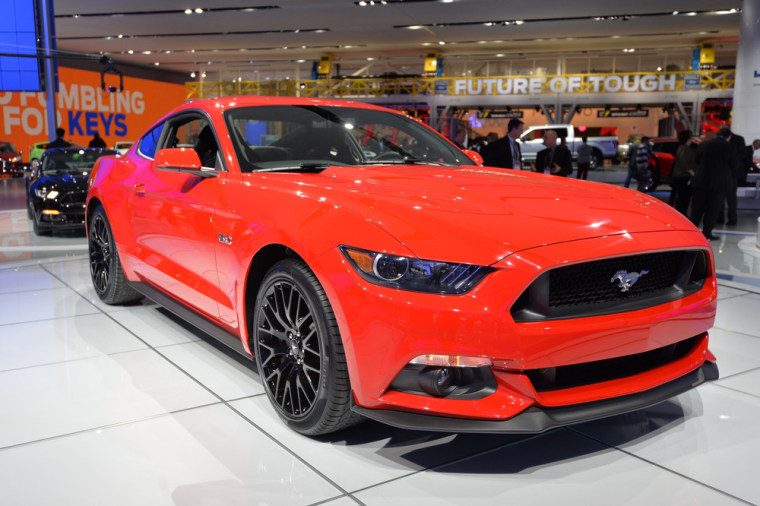We have seen the future at the Detroit Auto Show, and the future is muscle cars.
Judging by the number of beefy vehicles on display at the 2014 North American International Auto Show (as it’s formally known), the world’s automakers are betting that buyers have grown tired of stodgy and want something a bit more, well, sexy, when they get behind the wheel.
“Everybody is trying to come up with a halo car for their brand,” says Dave Sullivan, senior analyst with AutoPacific, Inc., referring to a hot auto that draws buyers to showrooms.
It could be a win-win for automakers that, despite the sluggish economy, are coming off an explosive sales year (thanks to demand for trucks). Muscle cars tend to be more expensive, but they give a brand cache that helps sales of its other vehicles.
It wasn’t like this last year. When the doors opened at Detroit’s Cobo Center for the 2013 North American International Auto Show, visitors were greeted by an array of new hybrids, plug-ins and pure electric vehicles, and even got the opportunity to drive some of the latest green machines on a special course in the sprawling convention center’s basement.
While there are a number of green machines on display as the 2014 auto show gets set to open to the public, the spotlight is shining in a different direction. Nowhere is that more apparent than at the Toyota stand.
Only last November, the Japanese giant detailed plans to put a new hydrogen car into production by 2015. But while a prototype is on display, Toyota’s big news for Detroit is the FT-1 sports car concept which, the maker notes, was outfitted with a classic, high-performance internal combustion engine, not one of its many hybrid drivetrains.
Toyota is by no means the exception. Muscle cars were in abundance during a two-day media preview earlier this week, with barely a word spoken about alternative fuel technology.
But for those who might fret about a return to the auto industry’s old, gas-guzzling ways, manufacturers did take pains to note that their newest performance cars are more fuel-efficient than in the past, the 450 horsepower Chevrolet Corvette Stingray, for example, getting as much as 30 miles to the gallon.
Chevy is back for more at the 2014 auto show with the unveiling of an even more potent version of the ‘Vette, the new, 625-horsepower Z06. Across the Cobo floor, Ford will be giving the public a first look at the all-new, 50th anniversary Mustang.
Toyota’s U.S. design chief Kevin Hunter told reporters that its show car – its name an abbreviation for “Future Toyota” – is “emblematic” of the direction it plans to go in the future, spurred on by CEO Akio Toyoda, a serious performance fan and occasional race car driver.
Then there’s Nissan. Perhaps no industry leader is more passionate about battery power than the second-largest Japanese maker’s own chief executive Carlos Ghosn. But plans to produce a high-end version of the Nissan Leaf electric vehicle for the company’s upscale Infiniti division have been put on hold “until late in the decade,” revealed Johan de Nysschen, a former Audi executive who took over the helm at Infiniti in late 2012.
In Detroit, the Nissan subsidiary focused on its Q50 Eau Rouge, a high-performance version of the midsize luxury sedan it launched for 2014.
“The question (is) whether you can be a serious global luxury brand without a performance division,” said de Nysschen, quickly offering the one-word answer, “No.”
Indeed, a quick check of the offerings at other high-line stands would support that position. BMW is using the NAIAS to introduce its new M3 and M4 high-performance models. Mercedes-Benz is launching a new 12-cylinder version of its big S-Class sedan and a new, high-powered S-Class Coupe. Lexus, the Toyota subsidiary that, in past years, rolled out a number of hybrids in Detroit instead is debuting its new RC F, a 450-horsepower screamer meant to compete with the new BMW M4.
Industry analysts caution that, by their very definition, halo cars tend to be low volume. But there’s significant demand for some models. The U.S. accounts for nearly half of the sales for Mercedes’ ultra-powerful AMG models, with Southern California alone generating nearly a quarter of worldwide demand, according to U.S. CEO Steve Cannon.
Sales in the so-called Premium Sports segment are expected to roughly double from 2011, when recession-racked demand bottomed-out, to around 62,000 in 2016, according to an AutoPacific forecast. Among more mainstream models, the consultancy expects the new Mustang to drive a 20 percent boost in demand, to 91,000 that year. Even little Subaru has big expectations for the all-new WRX STi “hot hatch” it is showing off in Detroit.
The good news is that by cutting out mass, improving aerodynamics and using new technologies, most all of these models are getting markedly better mileage than before. The engine in the Corvette Stingray, for example, uses direct injection and can even shut off half its cylinders when power demand is light. Most new Porsches have a Stop/Start function in which the engine shuts off instead of idling, firing up automatically when the driver’s foot lifts off the brake. And new double-clutch and 8- and 9-speed automatic gearboxes further improve efficiencies.
So, while the revival of the muscle car may frustrate environmentalists, regulators and insurance actuaries, fans are pleased to be getting what is for them the best of all worlds.
More from The Detroit Bureau:
